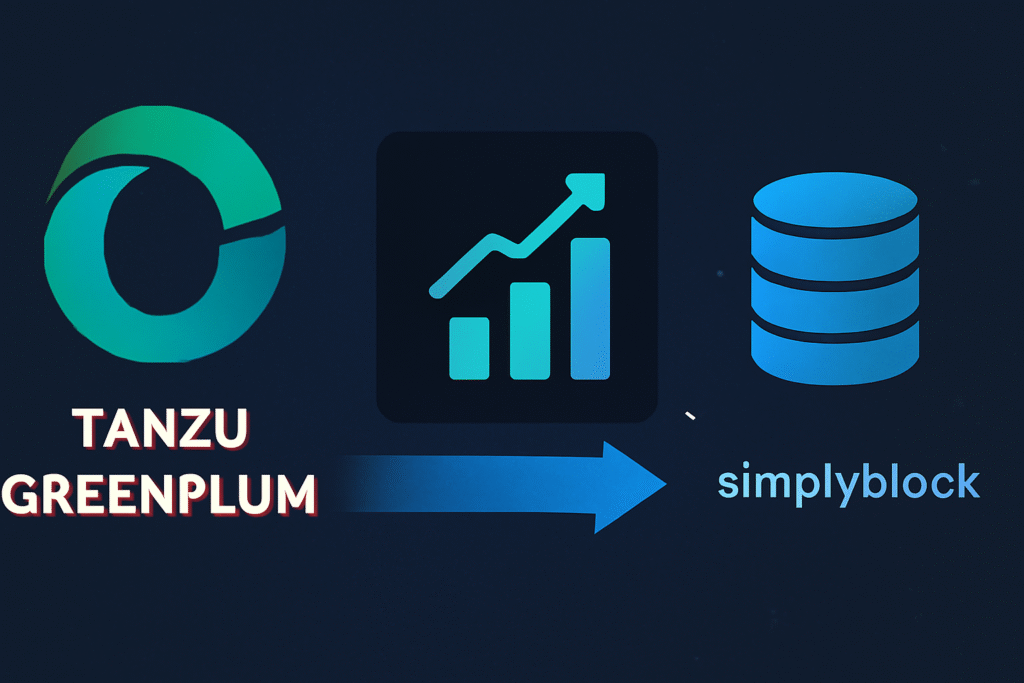Tanzu Greenplum is built for large-scale analytics, delivering parallel performance on massive datasets by distributing queries across PostgreSQL-based segment nodes. It’s ideal for data warehousing, business intelligence, and large-scale reporting. However, even the best MPP system is limited by storage performance. Table scans, joins, and WAL writes can cause slow queries, replication lags, and prolonged backups on standard volumes.
Simplyblock provides Greenplum nodes with NVMe-over-TCP performance, zone-resilient volumes, and live scalability, ensuring analytics workloads run smoothly at any scale.
Greenplum’s Parallel Queries Depend on Storage
Greenplum segments execute queries in parallel. Each node works on part of the dataset, but if storage is inconsistent, the cluster slows to the pace of its weakest disk. Uneven throughput leads to uneven query completion, and workloads that should finish in seconds drag out into minutes.
Simplyblock ensures every segment has consistent NVMe-level performance. That balance across nodes keeps distributed queries efficient and predictable, even under high concurrency.
🚀 Use Simplyblock with Tanzu Greenplum for Faster Analytics
Run parallel queries and large-scale analytics on storage that keeps up.
👉 Learn more about Software-Defined Storage with simplyblock →
Step 1: Provision High-Performance Volumes for Segment Nodes
Every Greenplum segment stores its portion of the dataset locally. If one segment has slow I/O, the entire query stalls waiting for it. By provisioning simplyblock volumes for each node, you ensure table scans, joins, and sorts are never slowed by weak storage.
sbctl pool create –name gp-pool
sbctl volume create –pool gp-pool –size 500Gi –name gp-segment1
mkfs.ext4 /dev/simplyblock/gp-segment1
mount /dev/simplyblock/gp-segment1 /var/lib/greenplum/data
This provides the consistency and performance needed to keep every segment in sync during parallel query execution.

Step 2: Keep WAL Writes and Replication Low-Latency
Greenplum inherits PostgreSQL’s WAL (write-ahead log) system for durability. Inserts and updates must be logged before they’re considered safe, and replication relies on these logs as well. On traditional volumes, WAL commits slow ingestion and replication falls behind.
Simplyblock’s NVMe-backed storage removes those I/O bottlenecks. WAL writes complete quickly, keeping ingestion rates high and ensuring replication between segments stays responsive. That stability is critical when Greenplum is handling real-time or near-real-time analytics pipelines.
Step 3: Speed Up Large-Scale Backups
Greenplum parallelizes backups across its segments, but the process remains I/O-heavy. On standard storage, backup jobs extend into long windows and interfere with production queries. This limits how often organizations can safely back up their data.
With simplyblock, parallel backups run at NVMe speeds, completing in a fraction of the time. Queries remain responsive while backups are in progress, making it feasible to protect data more frequently. This directly supports simplification of data management, where backup and recovery are no longer a drag on performance.
For more on how Greenplum is evolving to handle modern analytics at scale, check out the Pivotal Greenplum 6 and its new capabilities.
Step 4: Scale Storage for Growing Warehouses
Data warehouses grow quickly — and not always predictably. When volumes reach capacity on traditional infrastructure, the fix is disruptive: add nodes, migrate data, or take downtime.
Simplyblock volumes scale live. You can expand capacity while Greenplum continues running queries and managing workloads.
sbctl volume resize –name gp-segment1 –size 1Ti
resize2fs /dev/simplyblock/gp-segment1
This flexibility matches disaggregated storage models, where compute and storage scale independently without operational friction.
Step 5: Keep Analytics Clusters Resilient Across Zones
Enterprises often deploy Greenplum clusters across availability zones for reliability. But zone-locked storage creates problems when nodes reschedule, causing query failures and long failovers.
Simplyblock volumes are zone-independent, keeping data attached even when workloads shift. Combined with hybrid multi-cloud storage, this gives organizations the freedom to run Greenplum in distributed, fault-tolerant architectures without sacrificing performance.
For more information on high availability, see Overview of High Availability in Greenplum Database.
Greenplum and Simplyblock – Analytics Without Bottlenecks
Greenplum’s distributed architecture makes it powerful, but only if storage keeps pace with the parallel workload. On ordinary volumes, query performance, replication speed, and backup reliability all suffer.
Simplyblock brings NVMe-over-TCP performance, live volume scaling, and zone-independent durability to Greenplum clusters. The result: faster queries, shorter backup windows, and warehouses that scale seamlessly with growing data.
Questions and Answers
Simplyblock boosts Tanzu Greenplum by leveraging database performance optimization. With higher throughput and reduced latency, analytics queries execute faster, ensuring large-scale workloads stay responsive while maintaining consistent performance across distributed environments.
Tanzu Greenplum’s parallel query execution requires reliable, high-performance storage. Simplyblock delivers this through reduction of RPO and RTO, minimizing data risks while enabling faster analytics at enterprise scale without unpredictable bottlenecks.
Yes. With databases on Kubernetes, simplyblock provides Greenplum clusters scalable volumes, replication, and snapshots. This ensures predictable query performance, even in multi-tenant Kubernetes deployments where analytics workloads demand low latency and consistent throughput.
By integrating distributed storage systems, simplyblock keeps Greenplum queries consistent under high I/O demand. Features like snapshots and replication ensure predictable results, even as workloads grow, preventing degradation during intensive analytics operations across large datasets.
Yes. With cloud cost optimization, simplyblock outperforms cloud-native disks by delivering NVMe-class performance at reduced cost, ensuring Greenplum analytics remain scalable, faster, and consistent across hybrid or multi-cloud environments without storage throttling.

